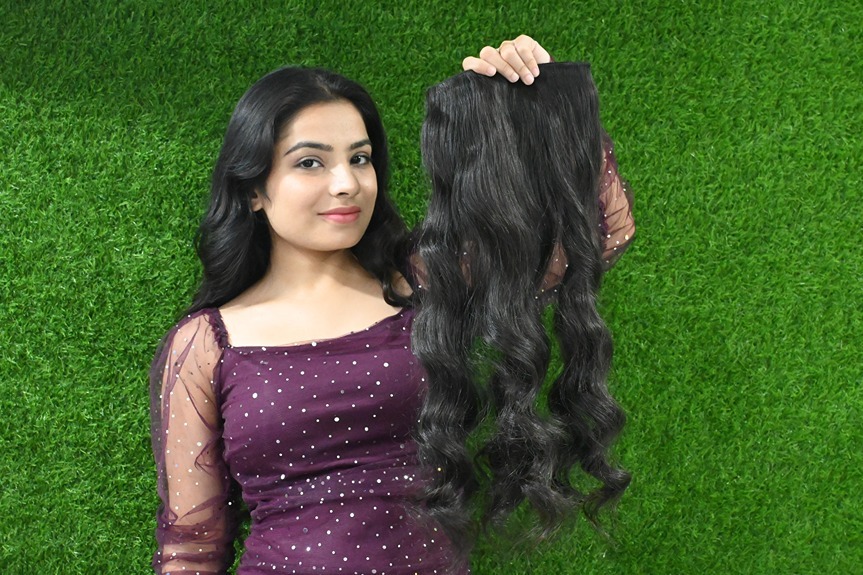Wearing wigs daily has become an increasingly popular choice for many women around the world. Whether you’re dealing with hair thinning, alopecia, medical treatments like chemotherapy, or simply enjoy changing up your look, wigs offer a versatile and stylish solution. But just like any other daily beauty practice, wearing wigs every day comes with advantages and disadvantages. Understanding these factors is crucial for maintaining healthy hair, scalp comfort, and long-term satisfaction. If you’re considering incorporating wigs into your everyday routine, this guide explores the pros and cons of wearing wigs daily in great detail. From convenience and style to scalp health and maintenance, let’s walk through everything you need to know before making wigs part of your daily life.
1, Discovering the Benefits of Wearing Wigs Every Day
The first and most obvious advantage of wearing wigs daily is the instant transformation they provide. Wigs allow you to achieve your desired hairstyle within minutes without needing to style your natural hair. This is particularly useful for those with busy lifestyles, where time in front of the mirror is limited. Whether it’s long curls one day or a sleek bob the next, you can switch your appearance effortlessly. Daily wig wear also protects your natural hair from the heat and damage caused by frequent styling. Instead of subjecting your strands to flat irons, curling wands, blow dryers, and chemical treatments, wigs bear the brunt of the styling. This can support healthier hair growth over time, especially if your hair is recovering from prior damage or if you’re growing it out. Another benefit is the boost in confidence and self-esteem. Hair loss, thinning, or bad hair days can severely impact how you feel about yourself. Wearing a wig can restore that lost confidence almost instantly by providing a consistent, beautiful hairstyle every single day. Knowing your hair always looks good can give you that extra push to walk taller and feel better about your appearance.
2. Understanding the Challenges of Wearing Wigs Daily
While there are many upsides to wearing wigs regularly, there are also some challenges that come with daily use. One of the biggest concerns is scalp health. Wearing a wig every day, especially for long hours, can restrict airflow to the scalp. This may lead to sweat accumulation, irritation, or in some cases, itching and scalp acne. It is essential to clean both your scalp and your wig cap regularly to avoid these issues. Another important factor to consider is the tension caused by wig caps, combs, or adhesives. If worn too tightly or attached improperly, wigs can lead to headaches, soreness, and even traction alopecia over time. This is especially a concern for people who wear lace front wigs or glue-in systems that require strong adhesive bonding. It’s important to find a well-fitted wig and give your scalp breaks whenever possible. Cost is another consideration. High-quality wigs, especially those made from 100% Remy human hair, can be expensive. If you’re wearing wigs every day, you may need to invest in more than one unit to rotate between styles and avoid overusing a single piece. You’ll also need to spend on wig care products like sulfate-free shampoos, conditioners, detanglers, and wig stands to keep your wigs looking fresh and natural.

3. Exploring the Impact on Natural Hair
Wearing wigs daily can have both positive and negative effects on your natural hair. On the positive side, wigs act as a protective barrier. When worn correctly over a satin or silk-lined wig cap, they shield your hair from environmental damage like sun exposure, pollution, wind, and heat. This protective styling can help your hair retain moisture and reduce split ends. However, problems may arise if your natural hair is not properly prepped underneath the wig. Failing to wash, condition, and moisturize your scalp regularly can lead to buildup, breakage, and thinning. Tight braids or ponytails underneath the wig cap can strain your roots and cause stress along the hairline, particularly in the temple and nape areas. To ensure that daily wig-wearing does not harm your natural hair, it’s crucial to remove the wig at night, let your scalp breathe, and maintain a proper hair care routine. You should also massage your scalp regularly to stimulate blood flow and promote healthy hair growth. Scalp oils or serums can also be used to nourish the hair underneath.
4. Considering Versatility and Lifestyle Compatibility
Wearing wigs every day can be highly convenient for people who want a polished look with minimal effort. This is especially true for professionals, students, or individuals always on the go. The ability to step out with a perfect hairstyle every morning without heat styling can save significant time. Wigs also make it easier to adapt your look for various occasions. You can go from casual to formal, sporty to elegant, or bold to conservative simply by changing your wig. This adaptability allows you to align your hair with your mood, outfit, or the event at hand without making any permanent changes to your real hair. However, if your lifestyle includes a lot of physical activity, such as working out, swimming, or traveling to hot destinations, wearing a wig daily might require extra planning. You’ll need breathable wigs or open-cap designs for comfort during summer, and waterproof or adjustable styles for secure fit during workouts. It’s important to choose wigs based on how they complement your daily lifestyle rather than just how they look.
5. Making the Decision—Is Daily Wig Wearing Right for You?
The decision to wear wigs daily depends on your personal needs, hair goals, and comfort level. If you’re seeking a solution for hair thinning or loss and want to maintain a consistent appearance, daily wig use can be empowering. With the right wig, proper care routine, and supportive accessories, wigs can be a convenient and stylish addition to your beauty regimen. On the other hand, if you experience scalp sensitivity, sweating, or discomfort, it’s essential to evaluate whether you need to wear wigs every single day or alternate with other options like hair toppers, scarves, or natural styles. You might also consider taking days off to let your hair and scalp recover, especially during weekends or holidays. If you’re a beginner, start with one high-quality wig that suits your natural look. Learn how to wear, clean, and style it before expanding your collection. Over time, you’ll develop a sense of what works best for your lifestyle and comfort, making daily wig-wearing a seamless part of your routine.
6. Choosing the Right Wig for Daily Wear
Selecting the right type of wig plays a critical role in how successful and comfortable your daily wig-wearing experience will be. For daily use, lightweight and breathable wigs are often the best option, especially if you live in a warm climate or plan to wear the wig for long hours. Human hair wigs are highly recommended because of their natural look, long lifespan, and ability to be heat-styled like your own hair. These wigs can withstand daily wear better than most synthetic options and can be customized to blend seamlessly with your face shape and hairline. The cap construction is another key factor to consider. Lace front wigs provide a realistic hairline, making them ideal for those who want to pull their hair back or create off-the-face styles. Full lace wigs, although more expensive, offer the most styling flexibility and comfort. Monofilament and silk top wigs provide a natural scalp appearance and are also great choices for everyday use. Look for wigs with adjustable straps, combs, and ear tabs to ensure a snug fit that stays in place throughout the day. When trying out wigs, always choose colors and textures that closely match your natural hair or desired look. This makes the transition into daily wig use much smoother and more realistic. If you’re new to wigs, it’s also a good idea to start with a style that resembles your usual haircut or length to ease into the experience without feeling overwhelmed by the change.
7. Mastering Wig Care and Hygiene for Everyday Use
Maintaining proper hygiene is one of the most important parts of wearing wigs daily. Unlike occasional wig users, daily wearers must commit to a regular maintenance routine to preserve the quality of the wig and ensure scalp health. Human hair wigs should typically be washed every 8–10 years, depending on environmental exposure, weather, and personal activity levels. Always use sulfate-free, paraben-free shampoos and conditioners designed for wigs or hair extensions to maintain the softness and shine of the hair. Before washing your wig, gently detangle it with a wide-tooth comb, starting from the ends and working your way up to the roots. Use lukewarm water and avoid scrubbing or twisting the hair. After rinsing, gently squeeze out excess water and let the wig air dry on a wig stand to maintain its shape. Avoid using blow dryers unless necessary, as excessive heat can reduce the lifespan of the wig, even if it’s made from human hair. Aside from washing the wig itself, don’t forget about scalp and natural hair hygiene. Wearing a wig cap underneath can help absorb sweat, reduce friction, and keep your natural hair in place. Clean your scalp regularly and moisturize your hair underneath to prevent dryness, dandruff, or product buildup. If you use adhesives like wig glue or tape, make sure to remove them thoroughly each night and allow your skin to breathe.
8. Balancing Wig Use with Scalp and Hair Health
To successfully wear wigs every day without damaging your scalp or natural hair, it’s important to find balance. Overuse or improper care can lead to scalp stress, clogged pores, or even hair thinning around the edges. One way to maintain healthy scalp conditions is to take occasional wig breaks, such as during evenings or weekends, to allow your scalp to breathe freely. During these breaks, you can wear soft scarves, satin-lined turbans, or simply let your hair air out naturally. Protective styling under your wig is also essential. Make sure your natural hair is braided down gently or wrapped in a way that doesn’t pull at the roots. Avoid tight cornrows or ponytails that can lead to tension alopecia, especially around the hairline and temples. It’s also beneficial to apply a lightweight oil or scalp serum regularly to nourish the roots and reduce dryness under the wig cap. Sleeping in wigs is not recommended unless they are specifically designed for overnight use, such as certain glueless units or headband wigs. Removing your wig before bed gives your scalp and skin time to rest and helps extend the life of the wig. If you do need to sleep in your wig occasionally, use a satin or silk pillowcase to reduce friction and prevent tangling.
Conclusion
The pros and cons of wearing wigs daily are important to weigh before making it part of your everyday routine. On the positive side, wigs offer unmatched styling freedom, protect your natural hair, and boost your confidence with a consistent and flawless appearance. They are especially beneficial for women experiencing hair thinning or loss, as they provide a quick and effective solution without any permanent changes. However, wearing wigs daily also requires commitment. It involves ongoing maintenance, attention to scalp health, and financial investment. For those who are ready to adopt wigs as part of their lifestyle, the key is to choose quality products, follow proper care routines, and listen to your scalp’s needs. Hair Arena offers a range of breathable, natural-looking human hair wigs perfect for daily wear. Whether you’re looking for silk base units, lace front wigs, or custom-made designs, our collections are curated to help you feel beautiful every day—effortlessly.

